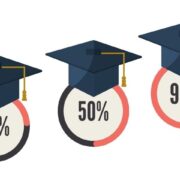Choosing a College: How Size Plays a Part in Your Decision
When it comes to choosing a college, size matters. The size of a college affects your experiences and opportunities, and size is usually among the first criteria families take a look at when making a college list. And while we would argue that the quality of the education/major program is more important than size when choosing a college, how big a school is will be near the top of the list of criteria impacting your decision.
Do you want to be among lots of other students cheering the football team in a packed stadium or getting lost in the crowd of a huge lecture hall? Would you prefer a more intimate setting where people know each other, you get to know your professors, and you say “hi” to friends in the dining hall? Do you simply want the opposite of whatever you had in high school? No matter your preferences when it comes to choosing a college, size has a big impact on what your college experience will be like.
How is college size typically defined?
Small colleges typically have fewer than 5,000 students. Often these are private colleges, but that isn’t always true. Medium colleges have between 5,000 and 15,000 students. Large schools tip the scales at over 15,000 students.
Size can also be a physical consideration—how big is the campus? How do I feel if it takes 30 minutes to walk from one side of the campus to the other?
Often the total number of students reported includes graduate, undergraduate, and commuter students. So, don’t assume that a college’s student size figure is just freshmen, sophomores, juniors, and seniors. Some colleges may have a large proportion of graduate and research students. Others especially in urban areas may have many commuters.
Class Size
During their campus visit presentations, colleges will mention their average class size. Knowing this number can give you a sense of how big your individual classes will be. However, average is just that the average! At large universities, freshmen lectures may still have hundreds of students in them, and you may attend an associated weekly class with a much smaller group for discussion. It is helpful to ask about the average class size of those general education classes versus the size of classes for upperclassmen.
Please note that just because a class is huge and the professor uses a microphone, it doesn’t mean that the class is bad. It can be a great class! You just need to understand how being in that size of a class will appeal to you. Will it impact your attendance? Some students will thrive in a large class and some won’t. The reverse is true for small classes.
What about majors? What kind of learner are you?
While not true 100% of the time, large universities generally have more college majors to choose from. They have bigger budgets and can afford more academic departments, professors, and all that goes with it. Many small colleges have healthy endowments that allow them to provide an excellent range of choices and resources as well. You need to ask some questions. How large is the faculty in your major? Do students find it easy to get in touch with them? Are graduate students usually teaching the first-year classes?
You may find that your desired major is small at a particular school. Is that Ok? Is it a small department at a large school or a large department at a small school? Are the exams multiple choice because there are so many students or will there be more papers and smaller projects? All will impact your experience. Again, neither is inherently good or bad. When it comes to choosing a college, it just depends on what you want your experience to be and how you will thrive as a student there.
Social aspect
This one is pretty easy to imagine. Smaller campuses tend to have more opportunities to get to know your classmates. You see familiar faces in the dining hall, at the library, etc. Large schools have plenty of opportunities for social contact—you might just need to work a bit harder at first to make those deeper connections and find your “group” who share your same interests. All colleges can be dangerous for those too distracted by the “social” aspect of college. While we all want to have a good time at school, remember why you are there and especially how much money you are spending to go!
Other considerations
- Honors colleges – Not all colleges offer these. They may be more prevalent at larger campuses. If this is important to you, be sure to include in your search criteria.
- Diversity – We can’t generalize about whether large campuses are more diverse than small ones, but you may find that to be true. It depends on the campus. When choosing a college, students seeking a diverse student body and college staff need to include that in their criteria.
- Students with learning differences – Again, it is really hard to generalize. Larger campuses may have more money for extra support programs, but they may also be more impersonal. The exact opposite could be true as well. Smaller schools may have teachers, students, and staff who are more naturally aware of what is going with each other.
How much support will the student need?
We are big fans of teaching a student how to self advocate. No matter the size of the campus, students need to be able to do things for themselves—make a phone call, talk to an academic advisor, find directions, grasp the processes at the school (how do you schedule classes?), make an appointment when they are ill or need a haircut. It is possible that students find it more difficult to self advocate on a larger campus because locating the right person may be more challenging. It might not actually be true, but their feelings about how successful they can be are the key.
College Visits
How can you know what size college is a fit for you? You can think about your preferences and learning style. (Guided Self Assessment often has the added bonus of helping you with self assessment skills like these.) You just have to visit.
Think about where you live. What colleges are close to you? Even if you don’t plan on applying to them, you might find it easy to visit a large, medium, and small school depending on where you live without too much difficulty. Or perhaps you make a weekend plan to go to a place where this is easier. Visit the library. Walk through the dining hall. Sit on a bench and observe.
Take in the off-campus vibe as well. Colleges may have a main drag with shops and restaurants. What’s that like? A large college may be in a small college town while a small university may be in a huge urban sprawl. All are factors to consider.
To summarize
We made lots of generalizations in this article. Not every large school will have lots of programs to choose from. Not every small college will have that cohesive sense of belonging. You have to visit, sit in on a lecture, ask a student some questions to really get a feel for a college and determine which size is right for you.
In the end, you may need to decide if you want to be a “big fish in a small pond” or a “small fish in a big pond.” Don’t get wrapped up in the thrill of a screaming, packed football stadium if the idea of a class in a large lecture hall isn’t also your thing. Small colleges may also have sports and all the school spirit and pride you need.
The most important thing is to have all these things in mind when researching, visiting, and choosing a college. Match up what you find to the strengths and needs of the student.
Updated 1/2024
Enjoy this post? Don’t want to miss any future blogs about education, college, or careers?











